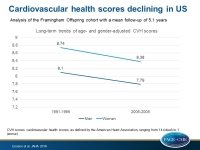CV health scores are declining and CVD rates are increasing in the US
CV health scores have decreased over the past 20 years, resulting in an increased risk of developing subclinical disease and incident CVD, as well as all-cause mortality.
Twenty-Year Trends in the American Heart Association Cardiovascular Health Score and Impact on Subclinical and Clinical Cardiovascular Disease: The Framingham Offspring StudyLiterature - Enserro DM, Vasan RS, Xanthakis V, et al. - J Am Heart Assoc. 2018;7:e008741.
Introduction and methods
Although CV mortality has decreased, CVD still causes high health care costs in the US. The ideal CV health, defined by the American Heart Association (AHA), is associated with decreased subclinical and incident CVD [1-3]. However, the temporal trend in ideal CV health of Americans is not known, and it might have decreased during the past 20 years, partly due to increasing rates of obesity.
In this analysis of a large community-based sample from the Framingham Heart Study [4], temporal trends in ideal CV health were evaluated, and their association with subclinical/overt CVD and death were assessed. 4139 Framingham Offspring cohort participants attending at least one examination cycle between 1991 and 2008 were enrolled. The exclusion criteria included prevalent CVD, serum creatinine levels ≥2 mg/dL, BMI <18.5 kg/m2, missing CV health score components, and extremely high lipid values. After application of the exclusion criteria, the study sample consisted of 3460 participants.
The (AHA) CV Health Score was calculated based on 7 variables (BMI, smoking status, physical activity, diet, fasting glucose concentrations, blood pressure, and total cholesterol levels). Each variable was scored with 2 if ideal, whereas a score of 1 was given for an intermediate status and a score of 0 for a poor status. The diet was evaluated with the food frequency questionnaire, and the physical activity with a questionnaire-based index and the Paffenberger Questionnaire.
Subclinical disease was considered as a diagnosis if participants had at least one of the following: increased carotid intima media thickness or stenosis, left ventricular hypertrophy or systolic dysfunction, reduced ankle-brachial index, or microalbuminuria. The outcomes of interest were incidence of all-cause mortality or the first CV event, including stroke or transient ischemic attack, myocardial infarction, coronary insufficiency, angina pectoris, intermittent claudication, or heart failure.
Main results
- The age- and gender adjusted mean CV health score declined throughout the study (median follow-up: 5.1 years; range: 0.1-1.75 years) from 8.74 to 8.38 for women, and from 8.10 to 7.79 for men.
- The decrease in CV health score is mainly caused by a decrease in the proportion of those with ideal status of BMI, blood pressure, glucose and cholesterol levels, with the highest decrease in those with ideal glucose levels.
- Participants with a high CV health score at baseline, who maintained it at high levels throughout the study, were used as the reference group, for the comparisons of the presence of subclinical disease, incidence of CVD and all-cause death.
- Compared to the reference group, participants with a low CV health score at baseline and throughout the study, had significantly higher rates of subclinical disease (HR: 2.86; 95%CI: 2.22-3.68; P<0.0001), incident CVD (HR: 1.90; 95%CI: 1.51-2.39; P<0.0001), and all-cause mortality (HR: 1.40; 95%CI: 1.09-1.79; P=0.008).
- Compared to the reference group, participants with a high CV health score at baseline that declined during the study, as well as those with a low CV health score at baseline that increased during the study, had significantly higher risks of subclinical disease, incident CV disease and all-cause mortality.
Conclusion
CV health scores, as defined by the AHA, have decreased over the past 20 years among American individuals, resulting in an increased risk of developing subclinical disease and incident CVD, as well as all-cause mortality. These results suggest that there is a need to intensify public health policies and community-based efforts to improve CV health scores in the US.
References
1. Nayor M, Enserro DM, Vasan RS, et al. Cardiovascular health status and incidence of heart failure in the Framingham Offspring Study. Circ Heart Fail. 2016;9:e002416.
2. Pase MP, Beiser A, Enserro D, et al. Association of ideal cardiovascular health with vascular brain injury and incident dementia. Stroke. 2016;47:1201–1206.
3. Xanthakis V, Enserro DM, Murabito JM, et al. Ideal cardiovascular health: associations with biomarkers and subclinical disease and impact on incidence of cardiovascular disease in the Framingham Offspring Study. Circulation. 2014;130:1676–1683.
4. Kannel WB, Feinleib M, McNamara PM, et al. An investigation of coronary heart disease in families. The Framingham Offspring Study. Am J Epidemiol. 1979;110:281–290.

